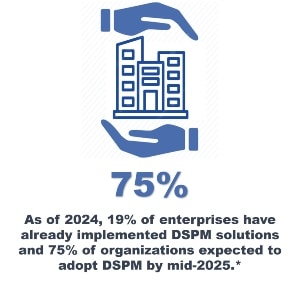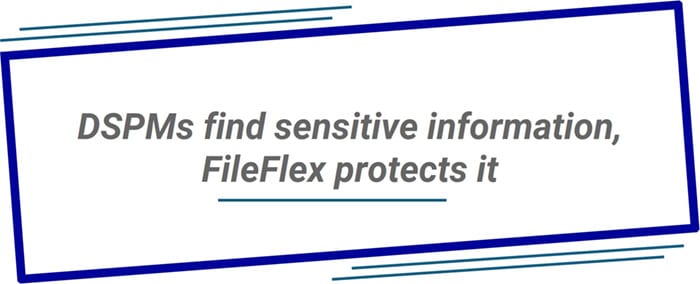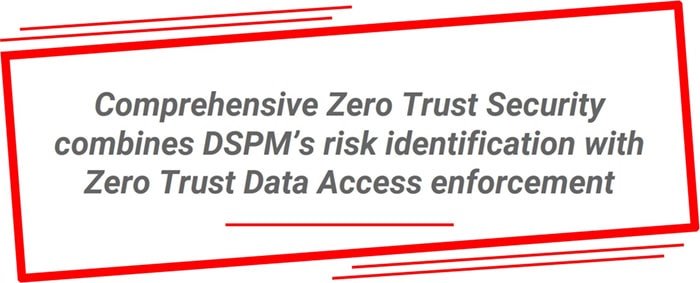
DSPMs (Data Security Posture Management systems) help organizations discover, classify, and secure data across cloud and hybrid environments. When combined with Zero Trust Data Access, they enable real-time policy enforcement and auditing at the data layer—delivering stronger protection and compliance.
DSPMs & ZTDA: Enhancing Zero Trust Data Security
Estimated reading time: 3 minutes
Table of Contents
-
-
-
- Introduction: From Risk Identification to Risk Prevention – A Unified Approach to Data Security
- What is a Data Security Posture Management (DSPM) Platform?
- How Zero Trust Data Access and DSPM Work Together
- Closing the Data Security Gap: ZTDA + DSPM
- Conclusion: Achieve True Zero Trust Data Security by Combining DSPM with ZTDA
-
-
Introduction: From Risk Identification to Risk Prevention – A Unified Approach to Data Security


What Is a DSPM?
A DSPM (Data Security Posture Management system) is a proactive cybersecurity tool that:
- Discovers and classifies sensitive data across multiple environments
- Analyzes access controls, risky configurations, and data movement
- Continuously monitors, alerts, and automates remediation to reduce data risk
Understanding DSPMs
DSPMs are security solutions that continuously identify, assess, and mitigate data security risks across an organization’s IT infrastructure.
Key Capabilities of DSPMs:
- Data Discovery & Classification – Identifies and categorizes sensitive data (e.g., PII, financial records, intellectual property) across cloud and on-prem environments.
- Risk Assessment – Evaluates data exposure risks, including misconfigurations, over-permissioned users, and unprotected sensitive data.
- Continuous Monitoring – Detects security threats such as unauthorized access, anomalous behavior, and potential data leaks in real-time.
- Compliance & Governance – Helps ensure compliance with regulations (e.g., GDPR, CCPA, HIPAA, PCI-DSS) by tracking data security policies.
- Access Control & Remediation – Provides insights into who has access to data and enforces least-privilege access through automated remediation.
- Integration with Security Tools – Works with SIEMs, SOARs, CASBs, and other cybersecurity tools to enhance security posture.
| DSPM Capability | Description |
| Data discovery & classification | Scans cloud/on-prem to find sensitive data (origin-www.paloaltonetworks.ca) |
| Risk & misconfiguration detection | Identifies vulnerabilities and risky access |
| Continuous monitoring & alerting | Tracks data behavior and flags anomalies |
| Policy enforcement & remediation | Automates actions like access revocation |
How DSPMs Differ from Other Security Solutions
- Unlike DLP (Data Loss Prevention), which focuses on preventing exfiltration, DSPM provides visibility into data risks across environments.
- Unlike CSPM (Cloud Security Posture Management), which secures cloud infrastructure configurations, DSPM identifies the data risks themselves.

How Zero Trust Data Access and DSPMs Work Together
While DSPMs identify risks, when properly configured, ZTDA as implemented by FileFlex Enterprise enforces Zero Trust access controls to ensure data security. Here’s how they compare:
| Feature | DSPMs | ZTDA | Together |
| Zero Trust Data Access | Focuses on monitoring, rather than enforcing access | Enforces least-priviledge access | Identifies risks and secures access |
| Data Discovery & Classification | Continually discovers & classifies sensitive data | Relies on existing classificaiton | DSPM finds sensitive data, FileFlex protects it |
| Continuous monitoring | Monitors data exposure & risks | Tracks file access & sharing | Enhanced visibility & control |
| Cloud & On-Prem Protection | Scans both for risks | Secures access to both | Comprehensive security coverage |
| Access Control & Policy Enforcement | Analyzes misconfigurations but doesn't enforce access | Enforces role-based access & MFA | DSPM flags security gaps, FileFlex locks them down |
| Compliace & Risk Management | Provides reports for compliance frameworks | Supports compliance via Zero Trust Data Access | Ensures regulatory compliance & security |
| Third-Party & External Sharing Security | Only alerts on risks, does not provide access control | Controls & monitors external sharing | Prevents risky external access |
ZTDA + DSPMs: Closing the Data Security Gap
By combining ZTDA as implemented by FileFlex Enterprise with a DSPM, organizations can move from passive risk identification to active risk mitigation.
- DSPMs scan your data landscape, finding risks and security gaps.
- ZTDA locks down access, ensuring only the right people, from the right device, can access sensitive files.
- Continuous monitoring ensures that any new security gaps flagged by DSPMs can be remediated with FileFlex’s Zero Trust Data Access controls.
Conclusion: Achieve True Zero Trust Data Security by Combining DSPMs with ZTDA
A DSPM platform tells you where your data is at risk—but that’s only half the solution. ZTDA as implemented by FileFlex Enterprise ensures that risk is mitigated by enforcing Zero Trust Data Access controls. Together, they create a comprehensive Zero Trust Data Security model that not only identifies vulnerabilities but actively prevents breaches before they happen.
Your DSPM platform tells you where your data is at risk. FileFlex makes sure it stays protected.
*Cybersecurity Insiders 2024 Data Security Posture Management Adoption Report
Ready to take the next step?
- Learn how FileFlex Enterprise complements your DSPM with Zero Trust data access.
- Request a personalized demo.
- Explore how we helped a major financial institution eliminate email-based file sharing and meet compliance with Zero Trust for data.
Frequently Asked Questions
What are DSPMs?
DSPM stands for Data Security Posture Management, a tool for discovering, classifying, monitoring, and remediating data risks across cloud and hybrid environments.
How do DSPMs protect data?
DSPMs help protect data by continuously scanning for sensitive content, detecting misconfigurations or exposed data, alerting on anomalies, and automating policy enforcement or corrections.
What is the role of ZTDA with DSPMs?
Zero Trust Data Access (ZTDA) complements DSPMs by enforcing continuous, file-level authentication, authorization, and access monitoring—preventing unauthorized data access in real time.